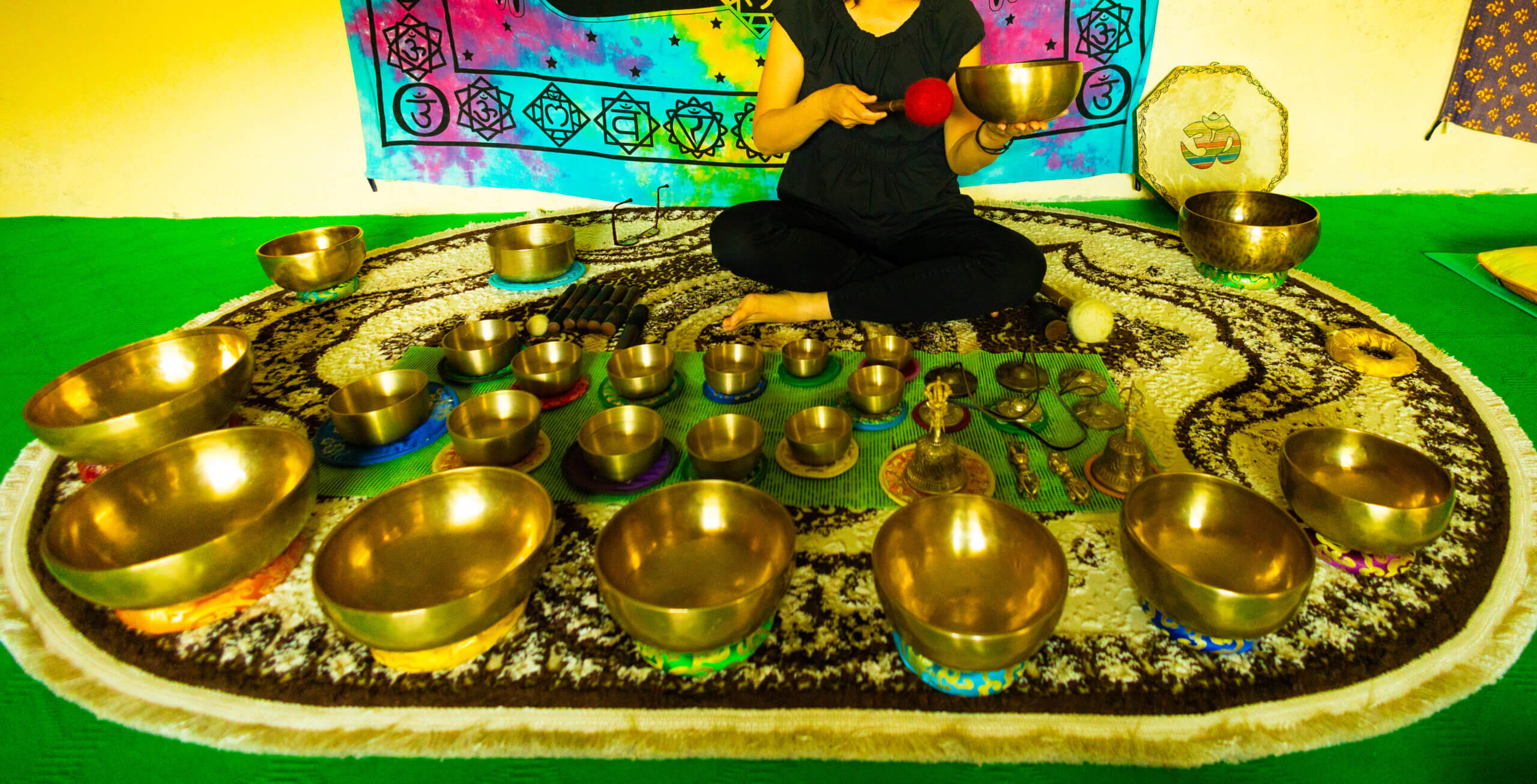The Healing Power of Himalayan Singing Bowls: My Journey as a Sound Healer
Himalayan singing bowls, often referred to as Tibetan singing bowls, are celebrated for their rich tones and therapeutic vibrations. They have been an integral part of spiritual practices and sound healing for centuries. While their connection to chakras, Solfeggio frequencies, and ancient traditions is well-documented, my personal journey as a certified sound healer adds a unique layer to understanding their profound impact.
In this blog, I’ll share insights from my certification experience in Pokhara, Nepal, and my discovery of the rare “Blue Moon Bowl” in Patan. Additionally, I’ll explore the science of sound healing, the differences between Himalayan and crystal bowls, and the symbolism of the metals traditionally used to craft these extraordinary instruments.
My Certification as a Sound Healer in Pokhara
Nestled beside a serene lake and surrounded by the Himalayas, Pokhara was the perfect setting to deepen my understanding of sound healing. After contacting several schools in Nepal to find the best fit, I adjusted my travel itinerary, skipping India entirely, to match the class schedules.
The certification program was both comprehensive and transformative, blending ancient wisdom with modern techniques. The school’s approach leaned toward traditional methods, emphasizing holistic practices over exact Hertz frequencies. This resonated deeply with me, as it allowed for an authentic learning experience from a skilled practitioner.
During the training, I learned the art of playing singing bowls to create harmonic vibrations that interact with the body’s energy field. Witnessing how these vibrations facilitate relaxation, balance energy centers, and promote healing was truly enlightening. This hands-on experience not only enhanced my technical skills but also deepened my appreciation for the spiritual dimension of sound therapy.
Chakras and Singing Bowls: Harmonizing Energy Centers
Himalayan singing bowls are often used in chakra healing practices. Among sound healers, traditional chakra bowls are typically larger in size, but these larger bowls do not always match the Solfeggio frequencies. Each bowl is tuned to resonate with one of the seven chakras, helping to clear blockages and restore balance:

| Chakra | Color | Frequency | Key Bowl Note | Location | Focus Area |
|---|---|---|---|---|---|
| Root | Red | 396 Hz | C | Base of spine | Grounding, stability |
| Sacral | Orange | 417 Hz | D | Below navel | Creativity, sensuality |
| Solar Plexus | Yellow | 528 Hz | E | Upper abdomen | Confidence, personal power |
| Heart | Green | 639 Hz | F | Center of chest | Love, compassion |
| Throat | Blue | 741 Hz | G | Throat | Communication, expression |
| Third Eye | Indigo | 852 Hz | A | Between eyebrows | Intuition, clarity |
| Crown | Violet | 963 Hz | B | Top of head | Spiritual connection |
Playing these bowls during sound healing sessions can help align the chakras, promoting emotional and energetic balance.
Solfeggio Frequencies: Ancient Sounds for Modern Healing
Solfeggio frequencies are an ancient set of musical tones believed to have therapeutic effects. Each corresponds to various aspects of healing and consciousness, aligning closely with singing bowl practices:
- 396 Hz: Releases guilt and fear; often associated with the Root Chakra.
- 528 Hz: Known for DNA repair and transformation; linked to the Solar Plexus Chakra.
- 852 Hz: Encourages spiritual awakening and heightened intuition; resonates with the Third Eye Chakra.
When Himalayan singing bowls are played in conjunction with Solfeggio frequencies, the combined effect can deepen relaxation, balance energy, and promote self-healing.
The Seven Metals: Spiritual Significance in Traditional Bowls
Historically, Himalayan singing bowls are crafted from seven metals, each symbolizing a celestial body and its corresponding spiritual essence:
- Gold (Sun) – Enlightenment, spiritual energy
- Silver (Moon) – Intuition, emotional balance
- Mercury (Mercury) – Communication, adaptability
- Copper (Venus) – Love, creativity
- Iron (Mars) – Strength, courage
- Tin (Jupiter) – Expansion, wisdom
- Lead (Saturn) – Transformation, grounding
These seven metals are said to infuse the bowls with holistic energy, connecting the cosmic and earthly realms.
Full Moon Bowls: Revered Across the Globe
The Full Moon Bowl is perhaps the most celebrated type of Himalayan singing bowl. Crafted exclusively during the full moon, these bowls are believed to absorb the heightened lunar energy, enhancing their vibrational qualities. Artisans work under the light of the full moon to imbue each bowl with clarity, intuition, and emotional resonance.
These bowls are widely known and cherished around the world for their ability to amplify meditation and chakra alignment practices. Their harmonious tones create a deeply immersive experience, making them a favorite among sound healing practitioners and enthusiasts alike.
During the trip, one of the merchants in Pokhara I spoke with shared that his company now makes singing bowls with 90% copper, 5% iron, and only about 1% of other metals. This modern approach reflects the reality of material availability and evolving craftsmanship, balancing tradition with practicality.
The Rare Blue Moon Bowl: A Hidden Treasure in Patan
While the Full Moon Bowl is globally recognized, the Blue Moon Bowl remains a rarity. During my travels in Nepal, a guide in Kathmandu mentioned its existence, though he was unsure about its specifics. Intrigued, I visited a shop in Patan, where the store owner shared detailed insights about these extraordinary bowls.
The shopkeeper, who is both a healer and the son of the Blue Moon Bowl maker, explained that only three families in Patan continue the tradition of crafting authentic singing bowls. However, his family is the only one that makes Blue Moon Bowls, crafted exclusively during a blue moon, an astronomical event that occurs every few years. This rarity lends the bowls their significance, symbolizing transformation, rare opportunities, and profound spiritual shifts. According to the shopkeeper, the tradition of the Blue Moon Bowl was much influenced by Tibetan monks.
Blue Moon Bowls are not openly displayed but are kept hidden until specifically requested, adding an air of exclusivity. The shopkeeper also revealed that while these families produce most of the genuine bowls sold in Nepal, many cheaper imitations found in markets are Indian-made.
When my guide took me to the shop alone, I had the opportunity to speak directly with the shopkeeper. He shared fascinating details about the craftsmanship and cultural significance of the bowls. He even placed a Blue Moon Bowl on my head to demonstrate its unique healing vibrations. This experience was intended to balance the differences in energy on either side of my head—a deeply personal and unforgettable moment. However, as the shop does not accept online orders, a revisit would be necessary to acquire one of these exceptional instruments.
Himalayan vs. Crystal Singing Bowls
Both Himalayan and crystal singing bowls are popular sound-healing instruments, yet they have distinct properties:
| Feature | Himalayan Singing Bowls (Handmade for professional use) | Crystal Singing Bowls (Machine-Made) |
| Material | Traditionally handmade with seven sacred metals | Pure quartz crystal, typically machine-made to ensure perfect pitch |
| Tone | Deep, warm, and grounding | Bright, clear, and ethereal; louder from precise crafting |
| Chakra Focus | Grounding and balancing | Amplification and heightened energy |
| Durability | Sturdy and travel-friendly | Fragile and stationary |
| Symbolism | Tied to ancient traditions | Modern sound therapy applications |
| Vibration Use | Suitable for vibration massage over the body | Large sizes unsuitable for body vibration massage |
While Himalayan bowls provide grounding vibrations, crystal bowls amplify high-frequency energy, making them ideal for focused chakra work and heightened meditative states.
Scientific Validation of Sound Healing
As sound healing evolves from its ancient roots to modern therapeutic practices, its effectiveness is increasingly supported by scientific evidence. Himalayan singing bowls, a cornerstone of sound therapy, have been studied extensively for their capacity to influence mental, emotional, and physical health. Here’s a closer look at how science validates the transformative effects of sound healing:
Psychological Benefits: Evidence in Focus
- Stress and Anxiety Reduction:
Harmonic vibrations from singing bowls have been shown to lower stress hormones like cortisol, promoting relaxation. Research by Leubner and Hinterberger (2017) revealed that sound therapy effectively alleviates symptoms of anxiety and depression, creating a meditative mental state. - Emotional Resilience:
Tibetan singing bowl meditations reduce tension and enhance emotional clarity. Goldsby et al. (2016) noted significant improvements in participants’ mood, particularly among first-time practitioners.
Physiological Benefits: Vibrations That Heal
- Cellular-Level Impact:
Vibrations produced by singing bowls stimulate the body’s natural healing mechanisms. Studies, including those by Stanhope and Weinstein (2020), highlight how these vibrations improve blood circulation, enhance lymphatic drainage, and even contribute to cardiovascular health. - Pain Relief and Relaxation:
Sound waves penetrate deeply, promoting muscle relaxation and alleviating chronic pain. These effects make SBM a valuable complementary therapy for pain management.
Blending Practices: Synergy and Amplification
- Integrated Healing Modalities:
The combination of SBM with practices like massage or meditation enhances its therapeutic outcomes. Research by Walter and Hinterberger (2022) demonstrated that singing bowl massages reduce heart rate and EEG power, fostering mindfulness and emotional balance. - Chronic Illness Support:
In patients with metastatic cancer, SBM has shown promise in reducing depressive symptoms and improving emotional well-being, as documented by Stanhope and Weinstein (2020). These findings emphasize SBM’s potential in serious health scenarios.
A Non-Pharmacological Solution
Singing Bowl Music Therapy offers a holistic, non-invasive alternative for managing conditions such as stress, anxiety, and depression. Its affordability and accessibility make it a practical choice for individuals and healthcare providers seeking complementary therapies.
From psychological relief to physical healing, scientific research continues to validate the benefits of sound healing with Himalayan singing bowls. As more studies emerge, Singing Bowls Music is increasingly recognized as a powerful tool for harmonizing mind, body, and spirit—bridging ancient wisdom with modern science.
Conclusion
Himalayan singing bowls offer a profound connection between ancient traditions and contemporary wellness practices. From their roots in spiritual ceremonies to their scientifically validated therapeutic effects, these instruments have become invaluable tools for promoting relaxation, emotional healing, and spiritual growth. Whether exploring the globally revered Full Moon Bowl or the rare and mystical Blue Moon Bowl, each singing bowl carries a unique resonance that harmonizes the mind, body, and spirit.
My journey as a certified sound healer has shown me how these bowls can transform lives by fostering a sense of balance and connection. I encourage you to explore these remarkable instruments, whether through a sound bath session, meditation practice, or simply experiencing their vibrations firsthand. The healing power of sound is a gift waiting to be discovered.
References
Goldsby, T., et al. (2017). Effects of Singing Bowl Sound Meditation on Mood, Tension, and Well-being. Journal of Evidence-Based Complementary & Alternative Medicine.
Goldsby, T. L., et al. (2022). “Sound Healing: Mood, Emotional, and Spiritual Well-Being Interrelationships.” Religions, 13(2), 123.
Lehman, S. (2020). The Human Health Effects of Singing Bowls: A Systematic Review. Journal of Evidence-Based Integrative Medicine, 25.












0 Comments